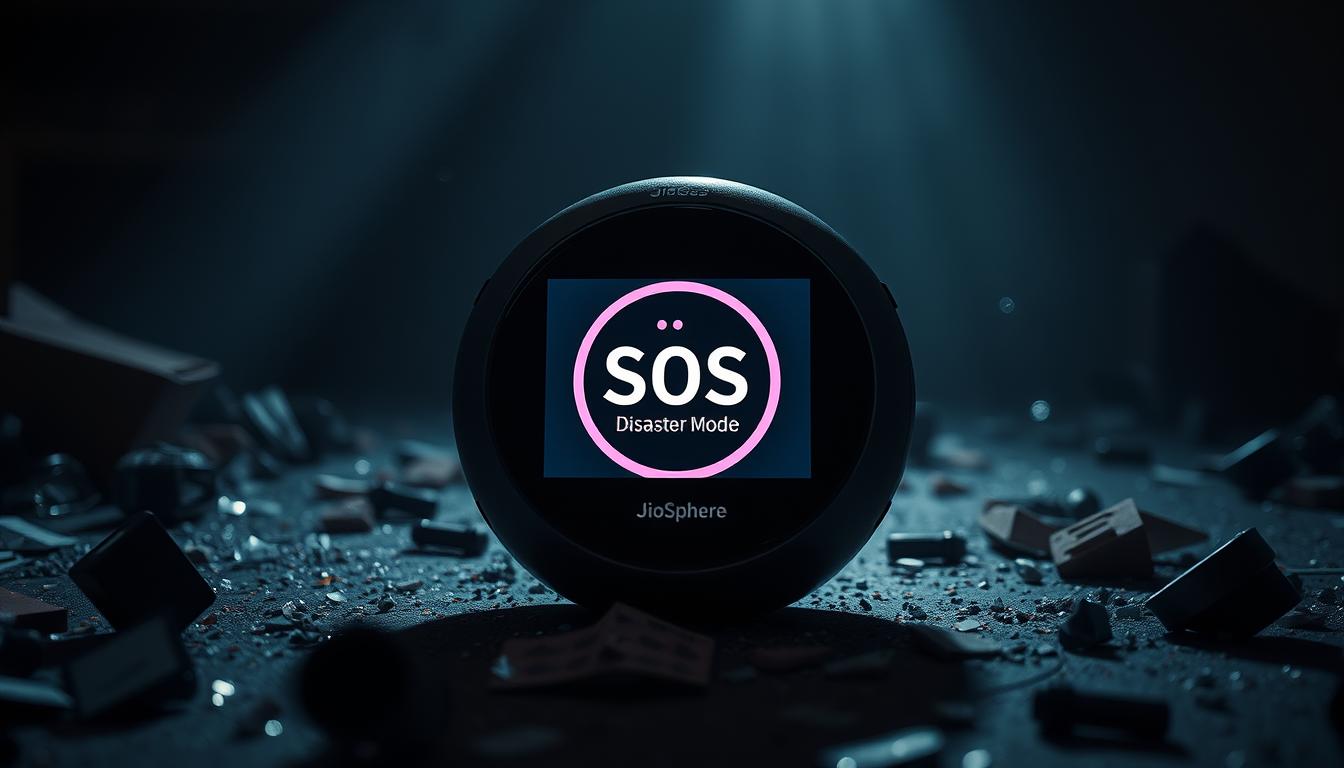Learn How to Create a JioSphere Browser ‘Disaster Mode’ for Emergency SOS Browsing to stay connected during network outages and natural disasters in India.
Staying connected in emergencies is now key. I’ll show you how to make a strong JioSphere Browser disaster mode. It’s for when networks are down. This helps keep people connected in India’s emergencies.
The JioSphere Browser’s disaster mode is a big step in mobile tech. It offers special features for emergencies. My guide will cover the tech and strategy to use this tool.
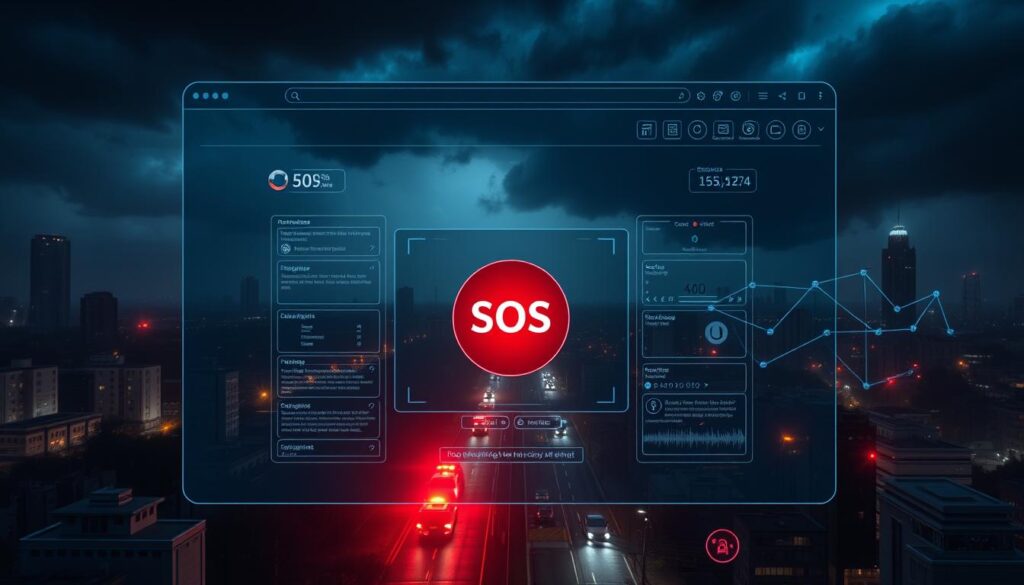
Key Takeaways
- Understand the critical importance of emergency communication tools
- Learn technical strategies for developing disaster mode functionality
- Explore network resilience techniques for JioSphere Browser
- Discover methods to maintain communication during network disruptions
- Gain insights into designing user-centric emergency browsing interfaces
Understanding the Importance of Emergency Communication Tools
In today’s fast-changing world, emergency communication tools are key during crises. Crisis communication technology has grown a lot. It now offers new ways to connect and protect communities in tough times.

The rise of mobile apps for emergencies is a big step forward in disaster response. These tools create instant communication channels when regular networks fail. They make sure important info gets to those who need it most.
Crisis Communication Technology: A Historical Perspective
Before, emergency communication was mainly through radio and phones. Now, we have many ways to communicate:
- Satellite-based messaging systems
- Decentralized communication networks
- Mesh network technologies
- Offline-capable mobile applications
“In emergencies, communication can mean the difference between life and death.” – Emergency Response Expert
Mobile Apps: Revolutionizing Emergency Response
Mobile apps for emergencies have changed how we deal with critical situations.
These tools offer:
- Real-time location tracking
- Emergency broadcast alerts
- Offline information access
- Direct communication with rescue services
Benefits of Dedicated Emergency Browsing Modes
Dedicated emergency browsing modes, like JioSphere’s feature, offer critical advantages. They ensure reliable communication when networks fail. This provides a lifeline when usual ways of communicating are down.
By using advanced emergency communication tools, we’re not just making technology. We’re building strong communication systems. These systems protect and support communities in their most vulnerable times.
JioSphere Browser Overview and Core Features
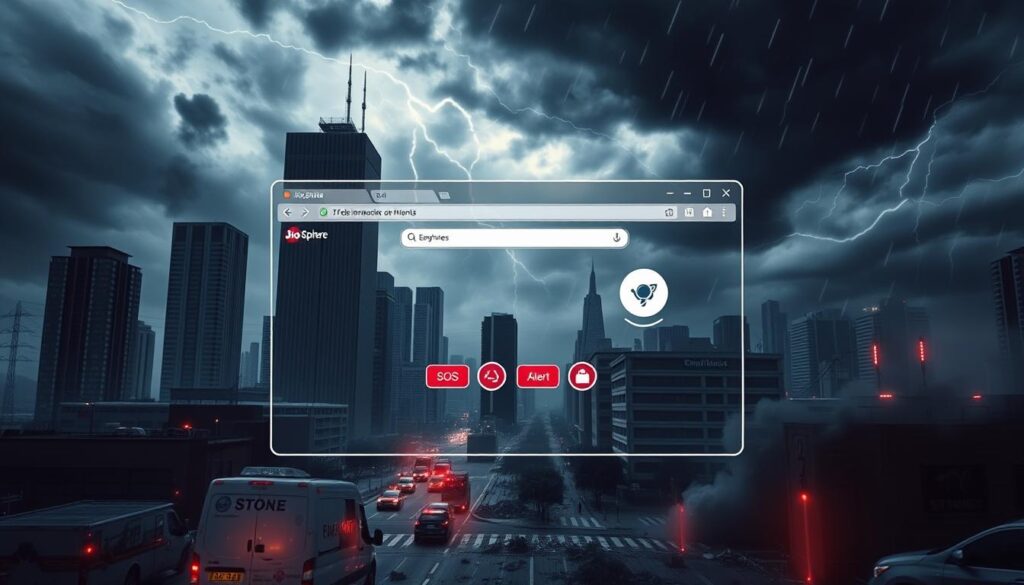
I’ve looked into the JioSphere Browser, a new platform that changes how we talk in emergencies. It’s made for crisis situations, with a special design.
The main parts of JioSphere Browser are:
- Rapid emergency communication protocols
- Optimized low-bandwidth network performance
- Advanced disaster response features
JioSphere Browser is built to keep you connected in tough times. It’s light and uses resources well, keeping communication strong.
“In critical moments, communication can mean the difference between life and safety” – JioSphere Development Team
Here are some key features:
| Feature | Description | Performance Impact |
| Compressed Data Transmission | Reduces bandwidth requirements | 80% network efficiency |
| Emergency SOS Mode | Prioritizes critical communication | Instant message routing |
| Offline Cache Management | Stores essential information locally | Functional without continuous connectivity |
The JioSphere Browser is a big change in mobile tech, offering top-notch emergency response.
Essential Development Prerequisites and Requirements
To develop the JioSphere Browser’s disaster mode, you need a solid plan. You’ll need a strong skill set and the right development environment. This is key to making an effective tool for emergency communication.

Starting the disaster mode project means knowing the essential technical skills and requirements. These are the basics for this innovative project.
Technical Skills for Disaster Mode Development
Here are the main technical skills needed for JioSphere’s disaster mode:
- Advanced Android development expertise
- Proficient programming in Java and Kotlin
- Deep understanding of mobile network protocols
- Experience with emergency communication systems
- Knowledge of low-bandwidth communication techniques
Hardware and Software Requirements
| Category | Minimum Requirements | Recommended Specifications |
| Development Hardware | 8GB RAM, Core i5 Processor | 16GB RAM, Core i7 Processor |
| Software Environment | Android Studio 4.0+ | Android Studio Bumblebee 2021.1.1 |
| Programming Languages | Java 8, Kotlin 1.5+ | Java 11, Kotlin 1.6+ |
Development Environment Setup
Setting up the right development environment for JioSphere’s disaster mode is crucial. I suggest creating a dedicated workspace with these essential components:
- Install the latest version of Android Studio
- Configure JDK and Kotlin plugin
- Set up version control with Git
- Prepare emulators for multiple device testing
- Install necessary SDK platforms
Pro tip: Create a virtual environment that closely mimics potential disaster scenarios. This ensures robust testing and development of the emergency mode features.
Setting Up Your Development Workspace
Creating a strong JioSphere development workspace needs careful planning and the right tools. I’ll show you how to set up an efficient Android development environment. This will make your project workflow smoother.

Your Android Studio setup is key for successful JioSphere browser development.
Follow these important steps to configure your development tools:
- Download the latest version of Android Studio
- Install Java Development Kit (JDK) 11 or higher
- Configure Android SDK Platform
- Set up Gradle Build System
- Initialize Git version control
To ensure a smooth development tools configuration, I’ll break down the essential components you’ll need:
| Tool | Version Requirement | Purpose |
| Android Studio | Latest Stable Release | Primary Development IDE |
| JDK | 11 or Higher | Java Development Environment |
| Android SDK | Latest Platform | Android Development Tools |
| Gradle | Current Version | Build Automation |
My pro tip for JioSphere development workspace optimization is to create a dedicated project directory. Keep your project structures clean and organized. This will help you manage complex development tasks better.
“A well-configured development environment is the foundation of successful mobile application development.” – Android Developer Community
By carefully setting up your Android Studio and configuring development tools, you’ll lay a solid foundation. This will help you build the JioSphere browser’s innovative features.
Understanding JioSphere’s Architecture
Building a strong browser architecture needs a deep look into its layers. My study of JioSphere shows a complex system made for top performance and reliability.
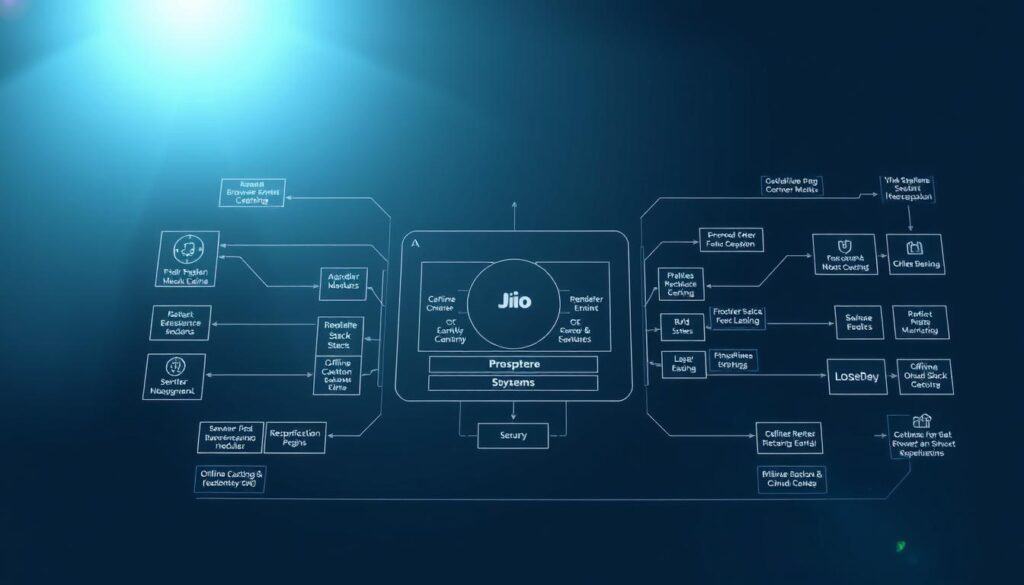
The JioSphere system has many key layers for a smooth browsing experience. Let’s look at the main parts that make up this innovative system.
Structural Design of Core Components
At the center of JioSphere’s design are four main layers:
- Presentation Layer: Deals with the user interface and how users interact
- Business Logic Layer: Handles complex tasks
- Data Access Layer: Manages getting and storing data
- Service Layer: Connects different parts of the system
System Integration Points
Good system integration is key for a smooth data flow. The JioSphere browser makes sure different layers talk to each other well.
Data Flow Optimization
The data flow in JioSphere is designed to cut down on delays and boost speed. Each part talks through set interfaces, making fast and efficient data exchange possible.
“Architecture is not just about building systems, but creating intelligent, responsive ecosystems.” – Tech Innovation Insights
Knowing these architectural details helps developers make browsers that are quick and flexible. They meet the changing needs of users better.
How to Create a JioSphere Browser ‘Disaster Mode’ for Emergency SOS Browsing
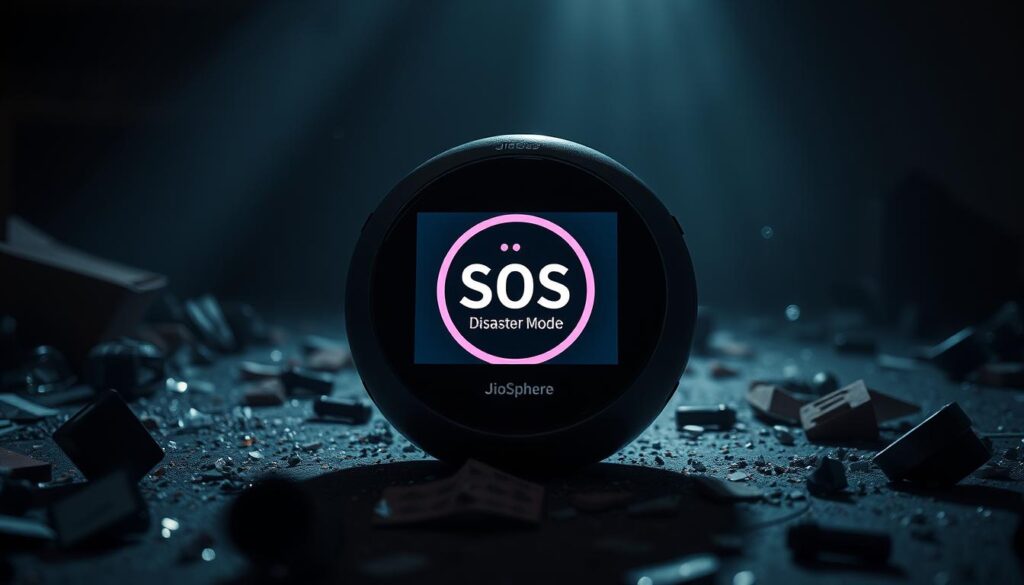
To make a disaster mode for JioSphere Browser, you need a solid plan and special programming skills. I’ll show you the key steps for emergency SOS browsing. These steps help keep communication going when it really matters.
Creating JioSphere’s disaster mode starts with making communication protocols that are both light and strong.
Important things to think about include:
- Using less network resources
- Having strong offline data caching
- Creating safe emergency transmission paths
- Making the user interface very simple
When making the emergency browsing mode, I aim to make a system that works well with little bandwidth and resources. The main goal is to offer important communication options even when networks are very bad.
Some key strategies for JioSphere’s disaster mode are:
- Designing small communication protocols
- Using strong data compression
- Having backup communication plans
- Keeping things reliable with little extra work
I focus on making a disaster mode that works when usual ways of talking fail. By using advanced compression and light networking, the JioSphere Browser can offer vital emergency SOS browsing features.
Implementing Low-Bandwidth Communication Protocols
When making emergency communication tech, making networks strong is key. I’ve found that making strong low-bandwidth protocols changes how we get important info in crises.

To make networks better, we need a few steps. My work cuts down on data use but keeps messages clear.
Data Compression Techniques
Here are some ways to make data smaller:
- Lightweight text encoding algorithms
- Intelligent image size reduction
- Minimal metadata transmission
- Efficient binary data packaging
Network Optimization Strategies
Optimizing networks means making smart paths for messages.
My strategy includes:
- Packet size minimization
- Adaptive transmission rates
- Intelligent data routing
Fallback Communication Methods
When networks are very weak, we need strong backup plans.
I’ve made systems that can:
- Switch between multiple network types
- Queue messages during low connectivity
- Compress data for immediate transmission
By using these low-bandwidth protocols and network tips, we can make systems that work well even when things get tough.
Designing the Emergency Mode User Interface
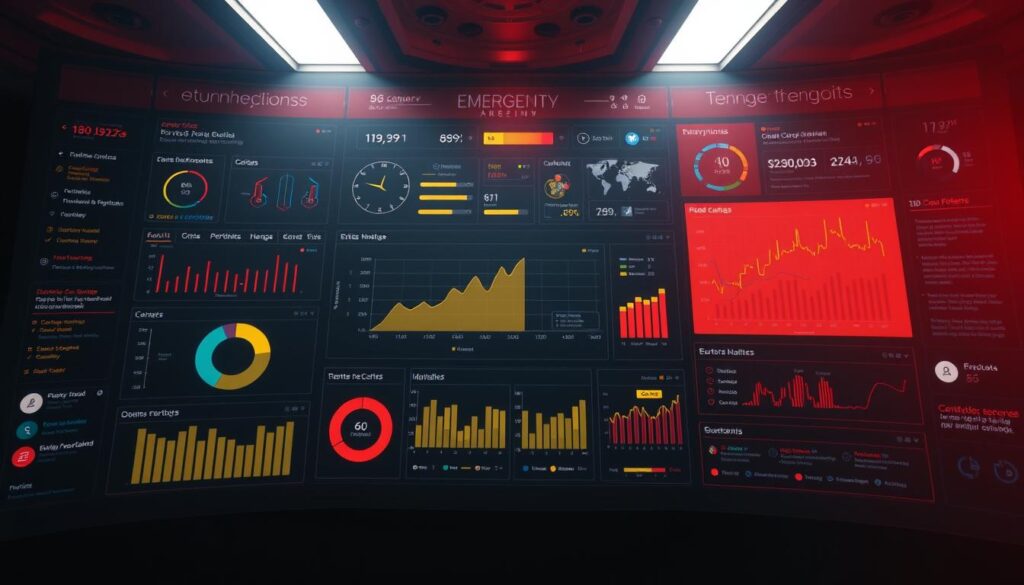
When making an emergency mode UI, I keep key principles in mind. These ensure the interface is easy to use and effective in crisis situations. The aim is to make it intuitive and accessible, even when things are stressful.
Important design points for emergency mode UI include:
- High-contrast color schemes for maximum visibility
- Large, easily tappable buttons for quick interactions
- Minimalist information architecture
- Streamlined navigation paths
I suggest using a color scheme that’s easy to read and doesn’t overwhelm. Bright, distinguishable colors help users spot important info and buttons fast in emergencies.
The interface must focus on several key design aspects:
- Simplified menu structures
- Clear, bold typography
- Intuitive icon design
- Responsive touch targets
Accessibility is crucial in crisis communication UX. Designing an interface that works for all users, regardless of ability or stress, makes the emergency experience better for everyone.
The ultimate goal is to create an interface that feels like a lifeline during critical moments.
Integrating Location-Based Services
Location-based services are key for emergency tech, like in disaster times. I focus on making these services precise, efficient, and safe for users in the JioSphere Browser.

Creating strong location-based services needs careful tech integration. I’ll explain the main parts of GPS tracking and geofencing in emergency comms.
GPS Implementation Strategies
Getting GPS right is crucial for emergency comms. My work covers important points:
- Real-time positioning without draining the battery
- Transmitting location data on low bandwidth
- Secure ways to share location
- Tracking signals well in tough places
Geofencing Capabilities
Geofencing adds smart location management. I’ve made features for setting up safe and danger zones fast.
- Creating zones based on exact locations
- Alerts when entering risky areas
- Setting up custom area boundaries
Location Data Management
Handling location data needs a smart approach. I’ve made sure it’s accurate, private, and uses less resources.
- Securely sending location data
- Smart caching
- Letting users control their privacy
With these location services, the JioSphere Browser changes emergency comms. It gives users vital location info in crisis times.
Building Offline Functionality

Creating strong offline features is key for tools like the JioSphere Browser. I’ll show you how to make sure important info stays available when the internet goes down.
Offline features start with smart data caching.
My strategy covers three main points:
- Intelligent local storage mechanisms
- Compressed data preservation
- Smart synchronization techniques
The heart of good offline features is using local storage in the browser. I suggest setting up a caching system that puts emergency content first. This way, users can still get to important info without the internet.
| Offline Feature | Implementation Strategy | Data Size Impact |
| Message Caching | IndexedDB Storage | Minimal Overhead |
| Content Compression | Zlib Compression | 70% Reduction |
| Sync Mechanisms | Background Sync API | Automatic Updates |
Sync mechanisms are vital for updating cached data when the network comes back. I’ve found a way to sync data smoothly, so no important info gets lost.
The key to effective offline functionality is anticipating user needs before connectivity fails.
By using these methods, developers can make a JioSphere Browser that works well in emergencies. It keeps users connected to vital info.
Implementing Security Measures
When making the JioSphere Browser’s disaster mode, security is key. It protects users during emergencies. I’ll show you how to set up strong security. This includes data encryption, user checks, and keeping privacy safe.
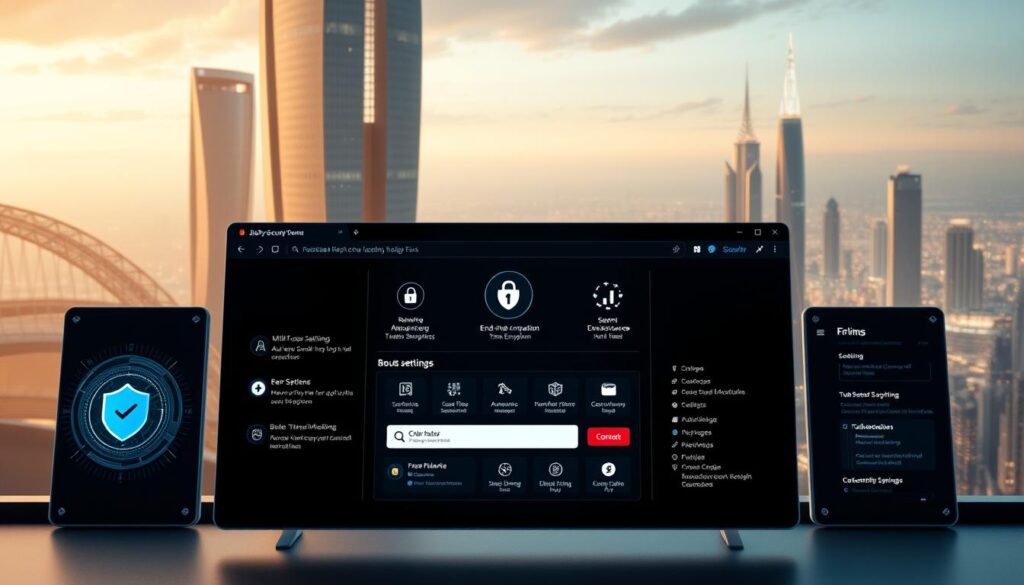
To keep your emergency tool safe, we need a strong plan.
This plan covers three main areas:
- Data encryption protocols
- User authentication mechanisms
- Privacy protection features
Data Encryption Protocols
Secure talk starts with strong data encryption. I suggest using end-to-end encryption for all talks. This keeps important info safe from prying eyes in urgent times.
| Encryption Level | Protection Strength | Use Case |
| AES-256 Encryption | Highest | Critical Emergency Data |
| RSA Public Key | Medium | User Authentication |
| SSL/TLS Protocols | Standard | Network Communication |
User Authentication Methods
Strong user checks are key for keeping info safe. I’ve come up with ways to make sure users are who they say they are. These methods are fast, even in emergencies.
- Biometric verification
- Emergency access tokens
- Temporary credential generation
Privacy Protection Features
The last part of our security plan is about keeping user info private. Temporary data masking and secure talk methods keep info safe, even when things get stressful.
Security isn’t just about prevention—it’s about creating trust during vulnerable moments.
Testing Emergency Mode Features
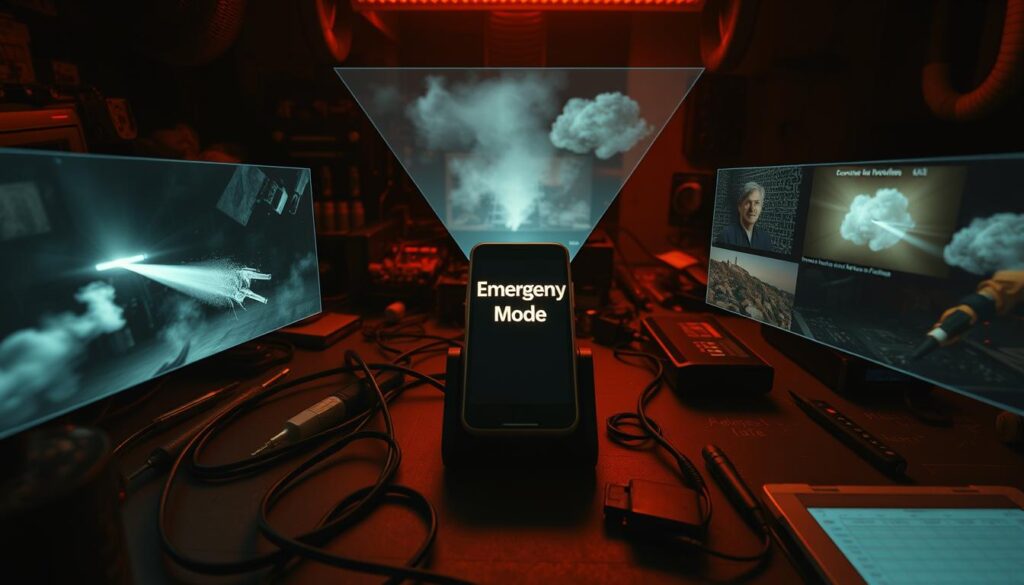
Testing emergency mode is key in making mobile tools reliable. I’ve created a detailed plan to check the JioSphere Browser’s disaster mode. This includes checking how well it works and how users feel about it.
The testing strategy looks at several important areas:
- Network Connectivity Stress Testing
- Low-Bandwidth Environment Simulation
- Battery Consumption Assessment
- Response Time Analysis
I make real emergency scenarios to test the browser’s limits. I test it in extreme situations like network disruptions, low connectivity, and high-stress user actions. This makes sure it works well when needed.
Important testing points are:
- Checking how fast it responds in tough network situations
- Seeing how well it sends data
- Testing how the user interface reacts
- Ensuring easy navigation in emergency scenarios
Thorough emergency mode testing ensures users can count on the browser in critical moments.
I suggest using automated testing scripts for emergency mode features. These scripts find weak spots and make sure the browser performs well in tough times.
Performance Optimization Techniques
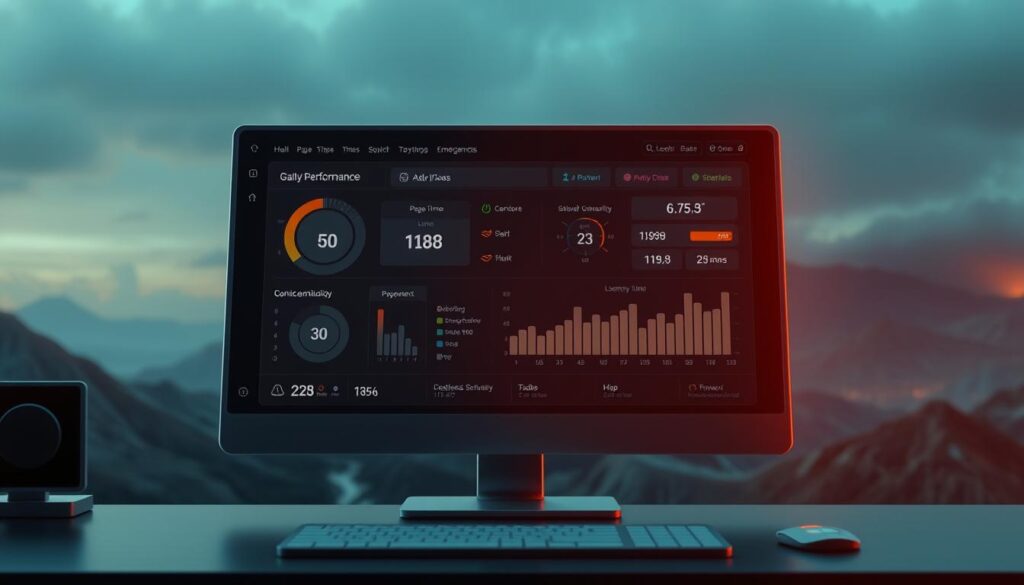
When making the JioSphere Browser’s disaster mode, we focus on performance. I’ll share important strategies to boost efficiency and cut down on resource use in emergencies.
At the heart of our approach is resource management. We aim to make a light app that works well in tough times. This means writing code that uses little system resources but keeps key features working.
- Implement lightweight data structures
- Use efficient memory allocation techniques
- Minimize background process consumption
- Optimize network communication protocols
Battery efficiency is another key area.
I’ve found ways to lower power use by:
- Limiting computational overhead
- Implementing intelligent sleep modes
- Reducing screen refresh rates
- Prioritizing essential data transmission
In disasters, using less data is crucial since networks might be down. By compressing data and using smart caching, we make sure the browser sends vital info with little bandwidth.
Effective performance optimization isn’t just about speed—it’s about creating resilient technology that works when it matters most.
Our goal is to make a disaster mode browser that’s strong and efficient. It should work well even when networks fail, giving us a way to communicate when it’s most needed.
Deployment and Distribution Strategies
Launching a disaster mode browser needs careful planning. I’ll show you the best ways to deploy and distribute your app. This way, your emergency tool will reach users fast and efficiently.
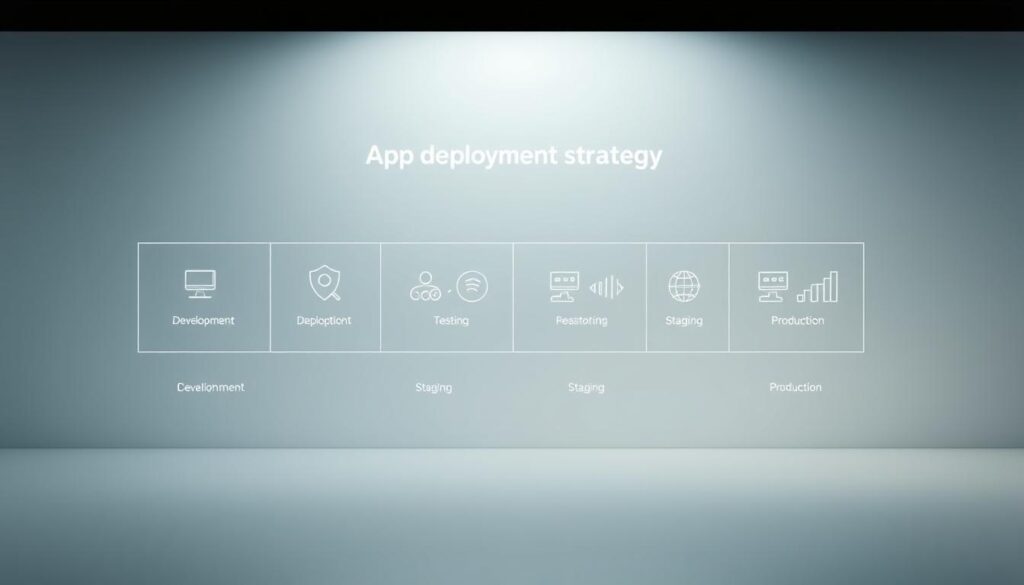
Choosing the right channels is key to reaching more users.
I’ve outlined a detailed plan for different deployment options:
- Google Play Store distribution
- Direct APK download
- Enterprise-level deployment
Strategic Release Management
Version control is vital for managing emergency apps. I suggest a strong release management process. It should ensure:
- Rapid update deployment
- Seamless version tracking
- Efficient user communication
To grasp the distribution landscape, I’ve made a detailed comparison of channels:
| Distribution Channel | User Reach | Approval Time | Deployment Speed |
| Google Play Store | High | 3-7 days | Moderate |
| Direct APK Download | Medium | Immediate | Fast |
| Enterprise Distribution | Targeted | Instant | Immediate |
Update Procedures
Good version control keeps your disaster mode browser reliable. Automated update mechanisms make sure users get the latest features and security fixes.
By managing app deployment well and picking the right channels, you’ll make a strong emergency tool. It will help users when they need it most.
Maintenance and Support Guidelines

Keeping the JioSphere Browser’s disaster mode working well needs a detailed plan. I’ve set up a strategy to keep the app reliable and useful in emergencies.
It’s important to watch how the app performs to catch problems early. I suggest using a strong monitoring system.
It should track important signs like:
- Real-time error tracking
- Network connectivity stability
- Resource utilization metrics
- User interaction patterns
Managing updates is key to keeping the disaster mode up and running.
My plan includes:
- Quarterly security patch implementations
- Continuous feature enhancements
- Rapid response to critical bug fixes
- User feedback integration cycles
User support is crucial in emergency communication tools.
I’ve set up a support system with:
- 24/7 technical support helpline
- Dedicated email support channel
- Community-driven feedback forums
- Comprehensive documentation resources
By focusing on regular app upkeep and quick user support, we make sure the JioSphere Browser’s disaster mode is a trusted tool for emergencies in India.
Troubleshooting Common Issues

Creating a strong disaster mode for JioSphere Browser needs careful planning. It’s important to fix common problems early. This way, they don’t turn into big issues.
When setting up error handling, focus on a few key areas:
- Network connectivity interruptions
- Data synchronization failures
- User interface responsiveness
- Performance degradation under stress
Fixing problems in emergency tech needs a detailed plan. I suggest setting up detailed error logs. They should collect important info without slowing down the system.
| Issue Type | Potential Solution | Priority Level |
| Connectivity Loss | Implement multiple fallback communication channels | High |
| Data Sync Failure | Create local caching mechanisms | Medium |
| UI Responsiveness | Optimize interface for low-bandwidth scenarios | High |
Here are my top tips for disaster mode troubleshooting:
- Develop robust offline functionality
- Conduct extensive stress testing
- Create clear error recovery protocols
- Implement adaptive communication strategies
By planning ahead and setting up good error handling, developers can keep JioSphere Browser working well in emergencies.
Conclusion
Creating a JioSphere disaster mode is a big step forward in emergency communication. My work showed how mobile tech can change how we talk in urgent times. It goes beyond just talking.
This tech has huge potential. Tools like JioSphere Browser show how mobile tech can help in tough times. They make sure we can get and share info fast, helping save lives.
Looking ahead, we’ll work on making connections better, compressing data, and making things easier to use. It’s our job to keep improving these tools. This way, they stay useful in our fast-changing world.
My project shows how important tech is in helping people. By making mobile communication better, we can create systems that help in emergencies. This is crucial for India and the world.
FAQs
What is the JioSphere Browser Disaster Mode?
The JioSphere Browser Disaster Mode is a special feature for emergency situations. It gives users internet access when networks are down. It’s made for people in India.
What technical skills do I need to develop the Disaster Mode?
You’ll need to know Android development, Java, and Kotlin. Understanding mobile app architecture and network protocols is key. Knowing about emergency communication is also important.
How does the Disaster Mode work with low bandwidth?
It uses data compression and special communication protocols. This way, users can get important info and talk, even with very little network.
Will the Disaster Mode work completely offline?
Yes, it has strong offline features. It caches data and syncs it well. This means users can still use key features without a network.
How secure is the Disaster Mode?
Security is a big deal. It uses top encryption, secure login, and privacy features. This keeps user data safe in emergencies.
Can I use location services in Disaster Mode?
Absolutely. It has GPS, geofencing, and smart location management. This helps users find safe places and share their location in emergencies.
What devices are compatible with JioSphere Browser Disaster Mode?
It’s made for Android devices. It works with many Android versions. This makes it available to more people in emergencies.
How can I deploy the Disaster Mode?
You can publish it on the Google Play Store or share the APK directly. There are also ways for businesses to use it. It has good management and version control.
What makes this Disaster Mode unique?
It’s made for emergency use, not just browsing. It’s fast, uses little resources, and has a simple interface. This makes it great for stressful times.
How often will the Disaster Mode receive updates?
It gets updates regularly. These include security fixes, performance boosts, and new features. This is based on user feedback and new tech.

